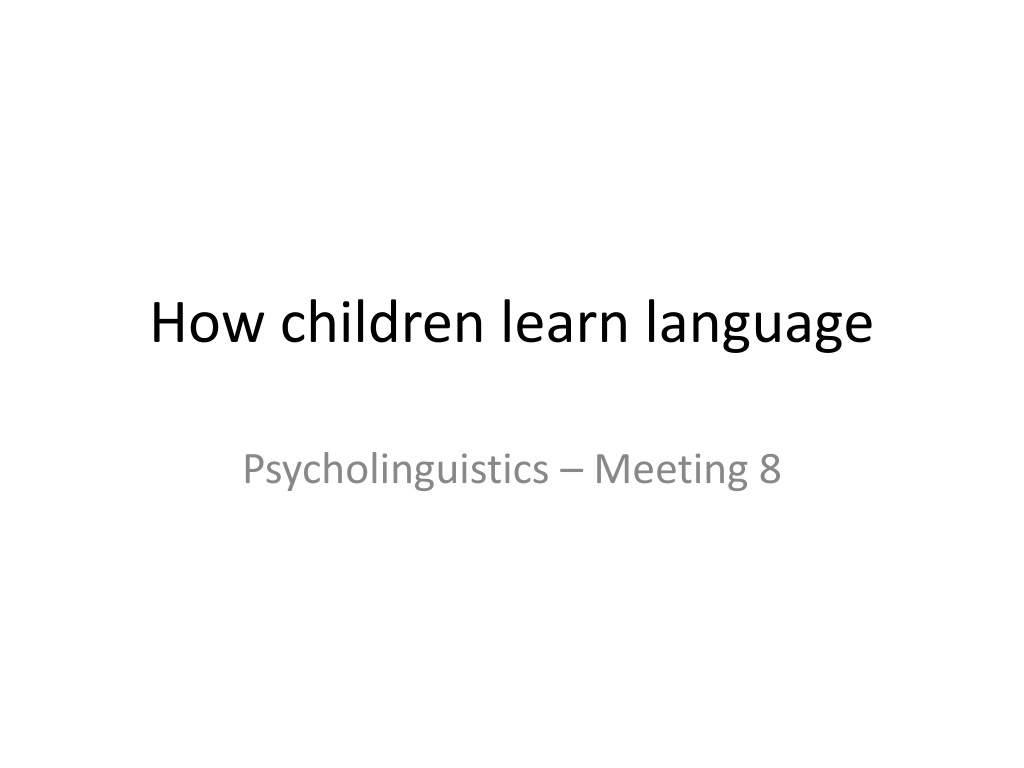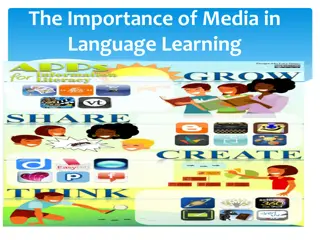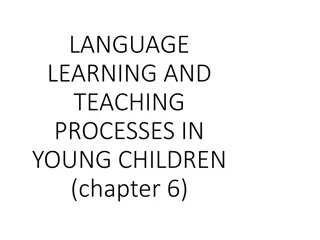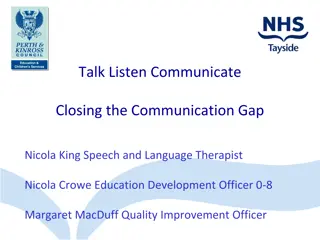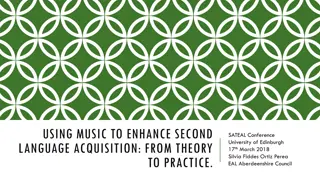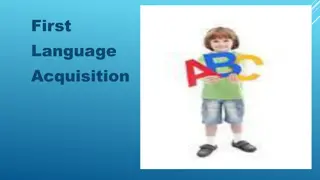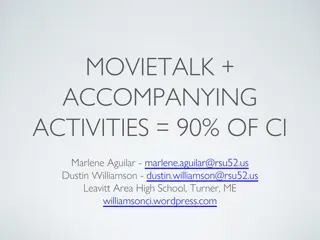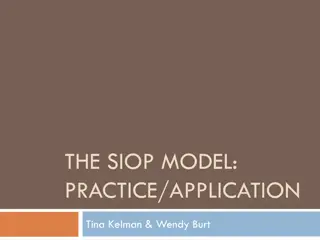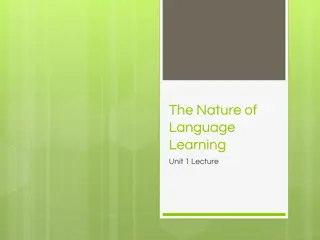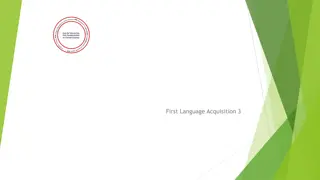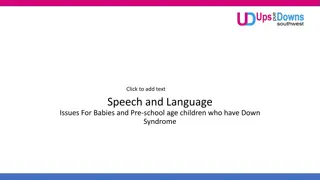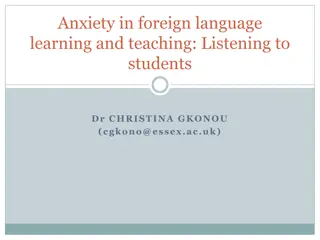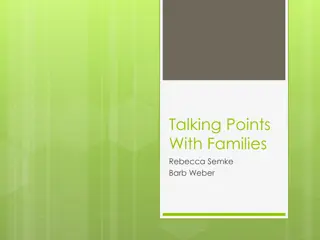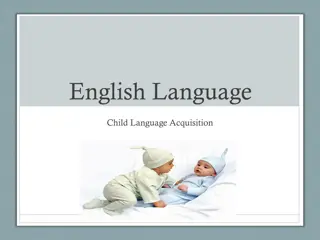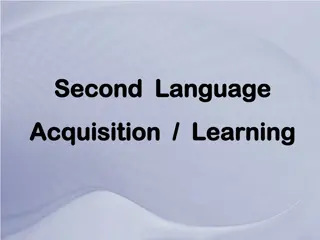The Fascinating Journey of Language Acquisition in Children
At birth, infants cannot comprehend or produce speech, but by the age of 4, they have acquired vocabulary and grammatical rules to form various sentence structures. From vocalization to babbling and then to speech, infants progress through distinct stages in language development. Understanding how infants perceive speech involves overcoming challenges related to segmentation, invariance, and language selection. The journey from babbling to uttering first words is a significant milestone in language acquisition.
Download Presentation

Please find below an Image/Link to download the presentation.
The content on the website is provided AS IS for your information and personal use only. It may not be sold, licensed, or shared on other websites without obtaining consent from the author.If you encounter any issues during the download, it is possible that the publisher has removed the file from their server.
You are allowed to download the files provided on this website for personal or commercial use, subject to the condition that they are used lawfully. All files are the property of their respective owners.
The content on the website is provided AS IS for your information and personal use only. It may not be sold, licensed, or shared on other websites without obtaining consent from the author.
E N D
Presentation Transcript
How children learn language Psycholinguistics Meeting 8
At birth we cannot comprehend speech, nor can we produce speech. Yet, by the age of 4 years we have learned vocabulary and grammatical rules for creating a variety of sentence structures including negatives, questions, and relative clauses. Although 4-year-olds still have passives and some other elaborate syntactic structures to learn, along with a never-ending stock of vocabulary items, they have already overcome the most difficult obstacles in language learning.
Vocalization to babbling Prior to uttering speech sounds, infants make a variety of sounds crying, cooing, gurgling. Infants everywhere seem to make the same variety of sounds, even children who are born deaf. Around the seventh month, children ordinarily begin to babble, to produce what may be described as repeated syllables ( syllabic reduplication ), e.g. baba , momo , panpan .
While most of the syllables are of the basic Consonant + Vowel type ( baba and momo ), some consist of closed syllables of the simple Consonant + Vowel + Consonant variety ( panpan ).
Babbling to speech It is from the advanced stage of babbling that children move into uttering their first words. Often this occurs at around 1 year of age but can occur much earlier or much later.
How infants perceive speech About 3 months before birth, you begin sensing sound and draw on this experience from the outset. You begin life with a preference for listening to speech over other complex sounds. How do infants break into the speech stream? They face three challenges:
The segmentation problem: How do infants figure out that a stream of speech can be segmented into phonemes? The invariance problem: How do infants identify a stable set of phonemes from a signal that is full of variation? For example, /p/ is pronounced differently according to whether it appears at the beginning or end of a word: compare pit (where /p/ is aspirated) to tip (where /p/ isn't aspirated). Add to that the fact that each speaker has a slightly different pronunciation, and that even the same speaker doesn't pronounce the same word twice in the same way. The language problem: How do infants figure out which set of sounds belong to their target language?
Initially young infants can discriminate (perceive whether two sounds are the same or different) phonetic sounds from any human language, even ones they haven't been exposed to. They retain this ability until the age of about 8 months, at which point they show a preference for the sounds of their target language. Infants pay more attention to the sounds that are most frequent. Being able to discriminate the sounds of a target language and to identify the most frequent ones are the first steps in solving the segmentation and to language problems.
By 8 months, infants are expert statisticians and keep score of which sounds hang out together. They detect regularities about which sounds are likely to occur with which other sounds, the typical stress patterns on words, and the difference between content words (such as verbs and nouns) and function words (articles such as the and auxiliaries such as be, have, do).
By 6 months, infants recognize familiar words, including their own names. By 9 months, they recognize sound patterns for words of their language. The ability to perceive words as units lays the foundation for the ability to produce single-word utterances.
How infants produce speech Calling attention: Crying The universal strategy of all babies everywhere is crying. Crying comes in regular bursts - there are pauses in between, and each sound burst falls in pitch as it goes on. And if the crying isn't immediately responded to, babies turn up the volume. These three ingredients - a rhythm of recurring sounds, modulation of pitch, and modulation of volume - lay the groundwork for speech.
Communicating before words: Cooing Babies are getting used to the shape of their vocal tract, figuring out where their tongue fits in your mouth, and learning to coordinate breathing and making sound. By 2 months, they've progressed to cooing. They experiment making consonant-like and vowel-like sounds these are not actual consonants and vowels - and they're soon stringing them together in longer sequences. Somewhere between the ages of 5 and 8 months, their natural ability as a phonetician bursts forth. Babies can produce all sorts of speech sounds, including ones that are not in their target language.
Research conducted by Catherine Snow indicates that adults provide turn-taking instructions to young infants. She reports the following interaction between a mother and her infant daughter of 3 months. Notice that the mother's feedback gives her daughter implicit instruction on turn-taking.
Daughter: (smiles) Mother: Oh, what a nice little smile. Yes, isn't that nice? There. There's a nice tittle smile. Daughter: (burps) Mother: What a nice little wind as well. Yes, that's better, isn't it? Yes. Daughter: (vocalizes) Mother: There's a nice noise.
By the age of 6 months, infants have figured out how to get adult attention through a mixture of vocalizations and gestures. But the adults are still doing all the work to create the conversation, interpreting any sounds the infant makes - from cooing to burping - as a conversational turn.
Babbling Next infants start to aim on their target language. By the age of 6 to 7 months, they're babbling away, and the sounds that they are using are getting closer and closer to being the sounds of their language. They repeat similar syllables and sounds over and over again: ba, ba, bi, bi, bu, bu. The ability to detect and produce sound distinctions not found in the infants language starts to fade away: By 9 months, their speech perception is focused on the sounds of their target language, and by 10 months their speech production locks onto their target language as well.
From phonemes to syllables to word 1. Stop consonants (/p, t, k, b, d, g, m, n, n/) and glides (y, w/) around 7 months 2. Vowels around 24 months 3. Fricatives /s, z/, affricates /ts, dz/, and liquids /r, l/ around 30-36 months Until they attain the motor control that allows them to produce all the sounds of their language, kids often omit or substitute sounds
Substitution Kids often voice consonants in initial position, and devoice consonants m the final position. So pie comes out as [bay] and knob comes out as [nap]. And until they figure out how to produce frication, they often substitute a stop for a fricative. So knife comes out as [naib], and bus comes out as [b d]. And because /r/and/l/ come in so late, kids often substitute those sounds with (y] and (w]. So rabbit comes out as [w bit].
Omission Kids often omit the final consonant of a word. So ball comes out as [ba], boot as [bu]. For words with more than one syllable, kids acquiring English, which has a stress-based intonation, often omit the weak (unstressed) syllable. So bye-bye comes out as (bab]. hello comes out as [hwow]. Stevie comes out as [iv], and away comes out as [wei]. This also means that they often omit grammatical words such as the and a (which are almost always unstressed). So a sentence like He catches the pig may come out as 'He catches pig.'
ln addition to learning the phonemes of their target language, kids also have to figure out how the sounds combine with each other. Kids' first words are often single CV syllables, like [ga], [da], [ba], [ma], and [na]. Then they move onto sequences of CV syllables, then CVC syllables, then syllables with long vowels (CVV, CVVC). And when they start making CVC syllables, they often produce forms where the two consonants have the same place of articulation, for example (tin] (where both [t] and [n] are alveolar) or (pom] (where both [p] and [m] are labial).
Language after the first year of life After infants get their first words out (at around 12 months), they start combining words with each other (at around 18 months) and then move onto more complex sentences (at around 24 months). By 3 years old, infants have a pretty good understanding of how their language forms words (morphology) and sentences (syntax) and how to use language appropriately (pragmatics).
Linguists give names to some of the stages that kids go through: The one-word stage (12 to 18 months) is also called the holophrastic or whole sentence stage. It's followed by the two-word stage (18 to 24 months) and then the telegraphic speech stage (24 to 30 months).
Major developmental stage: one-word stage (holophrastic) Naming Children can be said to have learned their first word when (1) they are able to utter a recognizable speech form, and when (2) this is done in conjunction with some object or event in the environment. First words have been reported as appearing in children from as young as 4 months to as old as 18 months, or even older. On average, it would seem that children utter their first word around the age of 10 or 12 months.
Holophrastic function Children do not only use single words to refer to objects; they also use single words to express complex thoughts that involve those objects. The child uses a single word to express the thought for which mature speakers will use a whole sentence. holo (whole) phrastic (phrase, sentence) Example: A young child who has lost its mother in a department store may cry out mama , meaning I want mama . Or a child may point to a shoe and say mama , meaning The shoe belongs to mama .
Two-word stage Around 2 years of age (18 to 24 months) or so children begin to produce two- and three-word utterances. They know about 50 words, and they use two-word combinations - this is the beginning of syntax. For example, Doggie bark for 'The dog is barking' expresses an agent-action semantic relationship and a subject-verb syntactic relationship. And Daddy hat, for 'Daddy's hat', expresses a possessor-possessed semantic relationship and a genitive-noun syntactic relationship. By this time, they can walk, feed themselves, and scribble lines with crayons.
Knitting together sound, meaning, and structure There's a rapid vocabulary expansion: At 24 months children know about 400 words, by 30 months they have around 900 words, by 36 months they're at 1,200 words, and by 48 months they're hovering at 1,500 words. There's also a rapid growth of syntax children now begin to master the forms of words, the rules of word order, the placement of negation, and the forms of passives, questions, and relative clauses.
Learning the forms of words In early stages of language acquisition, kids leave out grammatical words and word endings, in particular, inflectional suffixes. Figuring word order Between 24 and 30 months, kids figure out the rules for basic sentences. They use the subject-predicate pattern, for example, I good boy for 'I'm a good boy'. They also use the subject-verb-object pattern (Daddy like book for 'Daddy likes the book'), which they embellish on with an adverb (Man ride bus today for 'The man rode the bus today').
Going from active to passive By the age of two, kids start to use the passive-live sentence, but they don't fully master the passive construction until they're three. Eve Clark reports the following sentences: Adult models: My temperature was taken by the doctor. I want to see my bottle getting fixed. Child's version (26 months): I took my temperature from the doctor. I want see my bottle getting fix.
Asking questions As documented by Edward Klima and Ursula Bellugi, children progress in their mastery of both yes/no questions and content-questions in the following way: Stage I : see hole? and where kitty? Stage 2: you want eat? and where my mitten? Stage 3: will you help me? and where the other Joe will drive?
Forming relative clause By the age of two, kids unpack relative clauses into their component clauses. Dan Slobin and Charles Welsh report the following relative clauses produced by a 26- month-old child. It will take another two years for kids to master the form of relative clauses, but by the age of four they match the adult model.
Adult model: The owl who eats candy runs fast. The man who I saw yesterday got wet. Child's version (26 months): Owl eat candy and he run fast. I saw the man and he got wet.
Achieving a basic grammar By the age of five, kids have mastered the basics of their grammar. They can use language to talk about language, define words, and correct themselves. The rest is fine-tuning - vocabulary continues to increase (at a slower rate), and kids become more sensitive to stylistic variation.
